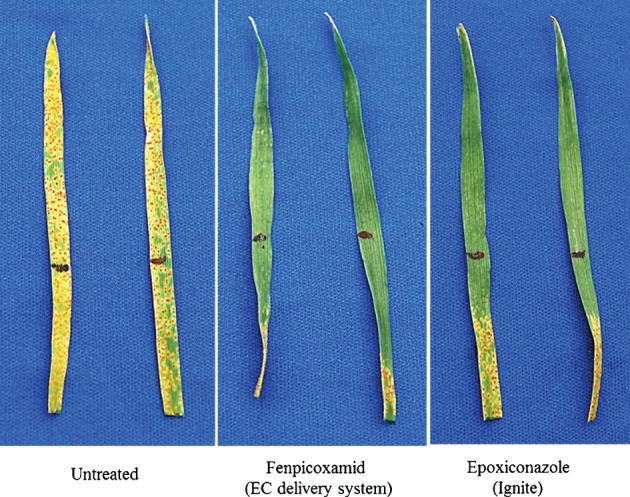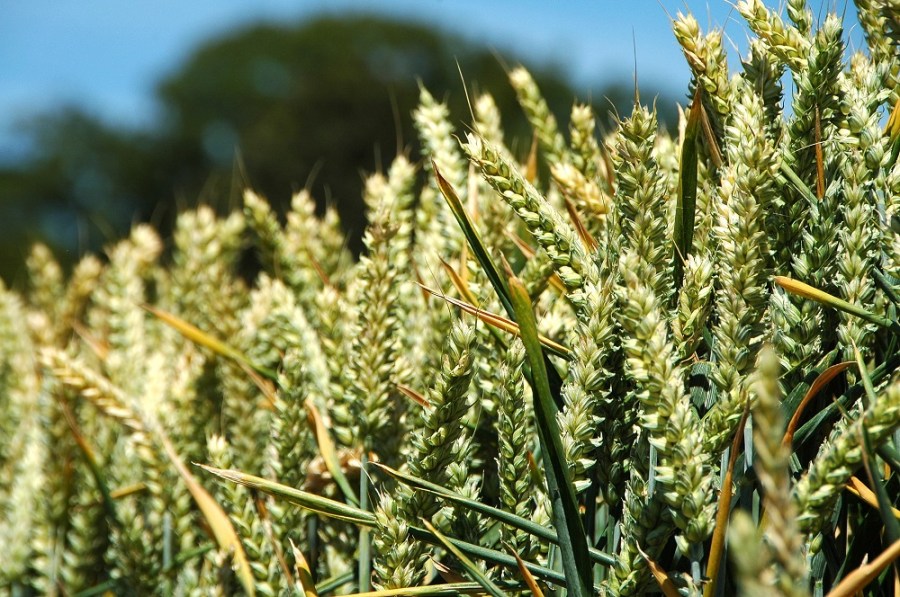Approval for a new fungicide molecule is anticipated later this year, adding a much-needed further option for septoria control. CPM reports from a briefing by its manufacturer, Corteva Agriscience, and bring you the technical low-down on ‘Inatreq active’.
Inatreq has no current cross-resistance to currently approved chemistry.
By Lucy de la Pasture
Approval for another new fungicide is expected hot on the heels of the recent approval for Revysol. The ‘Inatreq active’ molecule (fenpicoxamid) comes from Corteva Agriscience, and with agronomists reporting a noticeable slip in SDHI field performance this season, it couldn’t be a better time for the arrival of two new fungicides to take the pressure off existing chemistry.
“We anticipate approval in time for use in spring 2020,” says Stuart Jackson, field technical manager for Corteva.
“Inatreq belongs to the picolinamide group of chemistry and this will be the first registered for its use in cereal crops. It offers a different target site to other active ingredients that also inhibit mitochondrial respiration.”

Leaf bioassays showing redistribution of fenpicoxamid from mid-leaf points of application, compared with untreated and epoxiconazole.
Source: Owen, W. J. et al (2017), Biological characterization of fenpicoxamid, a new fungicide with utility in cereals and other crops. Pest. Manag. Sci, 73: 2005-2016. doi:10.1002/ps.4588
The Qo fungicides inhibit plant pathogens by blocking the pathogens ability to produce energy. The registration of Inatreq in cereals will be a significant step because it’s a quinone inside inhibitor (QiI) and the active binds to complex III at the Qi site on the cytochrome bc1 complex. The target site for strobilurins is also on complex III but at the outer binding site in the electron transport chain.
“The different binding site means Inatreq has no current cross-resistance to currently approved chemistry, even though the effect on mitochondrial respiration is the same as in the QoIs,” explains Stuart.
SDHIs also work by interfering with the energy production process in fungi but the target enzyme is succinate dehydrogenase, complex II in the mitochondrial respiration chain. This is a functional part of the tricarboxylic cycle and linked to the mitochondrial electron transport chain but is a different stage in respiration process, with a different target site and mode of action to Qo fungicides.
With the loss of chlorothalonil and a septoria population that’s constantly evolving insensitivity to the current fungicide portfolio, Inatreq will help take the pressure off the SDHIs while offering equal performance which, thanks to its nifty formulation, has better persistence, he highlights.
So what exactly is the Inatreq molecule? Stuart explains that it’s derived from a natural product, UK-2A, which is produced by soil-borne streptomyces bacteria.
“We produce UK-2A by a fermentation process but it’s not a photostable compound, so it breaks down in the presence of UV light,” he explains.
That meant the formulation whizz kids at Corteva had to photo-stabilise the UK-2A in order to make it work as a fungicide that’s applied to the surface of the leaf. They achieved this by adding a carboxy unit to crystals of UK-2A which modified it to become UV stable and this is Inatreq active.
“Once Inatreq is applied to the leaf surface, carboxylase enzymes in the plant cleave off the carboxy unit, converting it to the fungicidal molecule UK-2A, giving curative activity if the fungus has already invaded.
“The Inatreq is also stable within the leaf wax for many weeks, providing a reservoir of active ingredient which provides a long period of protection. As fungal spores land and put out their germ tube, the Inatreq is drawn up and converted by fungus carboxylase enzymes to UK-2A.
“The curative activity of Inatreq will be in the first 7-10 days after septoria infection. If the fungus is more than half-way through its latent period at the time of application then there won’t be any curative activity,” reminds Stuart.
Inatreq doesn’t move within the plants tissue so the formulation team at Corteva have come up with a patented formulation, named i-Q4, which has a special adjuvant system to help spreading on the leaf.
“We’ve found there’s no drop-off in efficacy with different application parameters because the formulation helps the spray droplets adhere to the leaf and minimises bounce-off,” says Stuart.
The Spray Application Unit at Silsoe has studied the way spray droplets spread over time compared with industry standard, Aviator (bixafen+ prothioconazole). “The Aviator moved along the ridges of the leaf whereas Inatreq moved across as well as along the leaf. This gave 97.5% coverage of the leaf compared with 73.1% from Aviator when applied using a Lerap 3-star air induction nozzle at 1.4 bar in a water volume of 120 l/ha at 8kph.
“We believe the iQ-4 formulation gives Inatreq its curative activity, improves both penetration and redistribution on the leaf, enables application in low water volumes, through low drift nozzles and at high forward speeds,” he sums up.
So how does this translate to disease control in the field? Trials results show levels of control that are much more consistent than the standard fungicide programmes used today, comments Stuart.
“Trials received a standard T1 treatment of an SDHI plus azole + CTL followed by either Ascra (bixafen+ fluopyram+ prothioconazole) at 1.2 l/h or Inatreq at 1.5 l/ha at T2. At four weeks after application the levels of disease control were very similar but at six weeks leaf one was cleaner,” he says.
Plots were taken through to yield and results show Inatreq 0.6t/ha ahead of the SDHI, although there was no statistical difference in the results.
The risk of resistance
Resistance management is likely to be at the heart of Corteva advice for using their new fungicide product, though the actual label conditions won’t be known until CRD have completed their evaluation.
Extensive trials have been carried out to evaluate the potential for resistance, including testing on strains of septoria with known resistance. The results show no resistance or cross-resistance to azoles, strobilurins or SDHIs.
The strobilurin fungicides provide an interesting benchmark in considering the potential for development as they have also been used to control septoria, act on the same mitochondrial‐encoded cytochrome b protein and appear to be affected similarly by the alternative oxidase pathway which can render the strobilurins ineffective.
The first strobilurins, kresoxim‐methyl and azoxystrobin, were introduced commercially in 1996 and 1997 and resistance in septoria occurred in 2000 caused by the G143A substitution. Their activity was soon severely compromised.
In a paper published by Young, D H et al in Pest Management Science (2018), the question of resistance was looked at in depth and the authors concluded it was unknown whether a comparable mutation conferring a high level of resistance to fenpicoxamid can arise in the field population.
The paper also reports that in lab studies by Bart Fraaije at Rothamsted Research, SDHI‐resistant laboratory mutants of Zymoseptoria triticido not show reduced sensitivity to fenpicoxamid. The authors suggest cross‐resistance between fenpicoxamid and SDHIs caused by target site mutations would not be anticipated based on their different modes of action.
“The new fungicide containing Inatreq will be widely available as a co-form with prothioconazole and our advice will be to use just once in the programme at T2 because of its long persistence,” says Stuart.
“A straight will be available through a limited distribution under strict resistance management guidelines,” he adds.
Reference: Young, D. H., Wang, N. X., Meyer, S. T. and Avila‐Adame, C. (2018), Characterization of the mechanism of action of the fungicide fenpicoxamid and its metabolite UK‐2A. Pest. Manag. Sci, 74: 489-498. doi:10.1002/ps.4743




